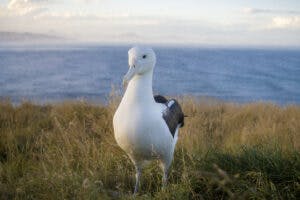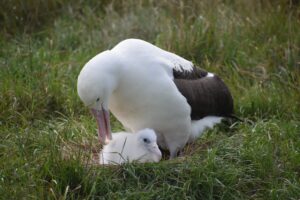NORTHERN ROYAL ALBATROSS / TOROA
(Diomedea sanfordi)
Albatross are the world’s largest seabirds. They usually breed on remote offshore islands and spend at least 85% of their lives at sea, well away from land and humans. Dunedin’s Taiaroa Head is the only mainland Royal Albatross breeding colony in the world.

Renowned ocean wanderers, they travel vast distances from their breeding grounds to feed. The Northern Royal Albatross, with its massive three metre wingspan, flies an estimated 190,000 kilometres a year.
These birds are also a taonga species to Māori, highlighting cultural significance and importance.
The breeding birds arrive at Taiaroa Head on Otago Peninsula in September. They nest during early November and within the following three weeks an egg is laid – they are slow breeding birds and lay only one egg per pair every two years.
The parents share incubation duty as it lasts a period of 80 days! The chicks hatch from late January to early February, and both parents take turns at guarding the chick for the first 35 days to protect it from predators. After that the chick is by itself, with parents only returning with food every few days. It takes eight months for the little balls of fluff to become not so little juveniles, and they will finally take their first ever flight in September! 12 months after their arrival at Taiaroa Head, the chicks’ parents finally leave the colony to spend a year at sea before returning to breed again.

The young Royal Albatross will spend the next three to five years at sea, never touching land during that time. Many then return to this unique headland to start another generation of Royals at Dunedin’s Taiaroa Head.
The Royal Albatross Centre, The Otago Peninsula Trust, and the Department of Conservation combine to protect and preserve the albatross of Taiaroa Head and have initiated many research projects, alongside the University of Otago, so that we may better understand these majestic seabirds. A portion of every ticket sold at the Royal Albatross Centre goes directly towards the fostering and protection of the Northern Royal Albatross.
ROYAL CAM
Check out the live webcam of one of our Royal’s nests! Royal Cam runs 24 hours a day, tune in to watch what is happening on Taiaroa Head.

Follow our 2023/24 Royal Cam chick at the Top Flat nest site!
2023/24 Royal Cam Chick Profile:
- Egg laid: 7 November 2023
- Chick hatched: 23 January 2024
- Mum: LGL (lime green lime) currently 15 years old
- Dad: LGK (lime green black) currently 12 years old
- Nest site name: Top Flat
Chicks Fledged:
- 2013/14 season: 26
- 2014/15 season: 24
- 2015/16 season: 23
- 2017/18 season: 13
- 2018/19 season: 28
- 2019/20 season: 24
- 2020/21 season: 30
- 2021/22 season: 25
- 2022/23 season: 33
- 2023/24 season: 41 viable eggs…pending!
THREATS TO ALBATROSS
There are 22 species of albatross around the world, 18 of these are considered threatened on some level.
The New Zealand Conservation Status of the Northern Royal Albatross is Threatened – Nationally Vulnerable. They have only two nesting sites worldwide; 1% here at Pukekura / Taiaroa in Dunedin (estimated 70 breeding pairs), and the remaining 99% on the Chatham Islands (estimated 5,500 breeding pairs) where numbers are in decline.
The main threats: plastic pollution, long-line fisheries, and effects of climate change.
As albatross spend at least 85% of their lives at sea, there are many threats that can affect their chance of survival.
Albatross are opportunistic scavengers, taking food such as squid, fish and octopus from the ocean’s surface. This style of hunting makes them vulnerable to ingesting plastic, as small fragments float conveniently along the surface of the water appearing the same as food items.
Long-line fisheries are responsible for thousands of albatross deaths each year as a result of bycatch from easy-access baited hooks floating near the surface. The invention of the Hookpod is helping to practically eliminate the rate of seabird bycatch.
Climate change effects many things from sea surface temperatures and food availability, to stormy weather events and stress levels. As temperatures rise, prey migrate further down the water column making them less available to seabirds, particularly albatross which are shallow divers at best. Stormy weather is known to spray seawater onto nesting grounds, killing grass used as nesting material, leaving bare rock in it’s place. This, combined with increased stress levels causing thinner egg shells, results in a high proportion of broken eggs and unsuccessful breeding pairs.

Stomach contents of a Laysan Albatross chick, Midway Atoll, containing 52 items of plastic.
The work done by the Department of Conservation at Taiaroa Head, funded by you, is essential if we are to have any chance at protecting this endangered species. The Northern Royal Albatross found in Ōtepoti travel thousands of kilometres across the oceans each year, encountering a whole host of threats. By reducing our usage of single-use plastics and sourcing our fish sustainably, we can help protect what we have left.
HOW YOU CAN HELP
The Otago Peninsula Trust is a not-for-profit charitable conservation trust, relying on the help and support from you! There are a few ways in which you can help:
-
Visit Us – Plan a day out on the peninsula! Click here for more info.
-
Get Involved – Become a member today! Click here for more info.
-
Donate – Donations are a fantastic way to ensure that the work done to protect our wildlife can continue. Go to our Givealittle Fundraising page.
